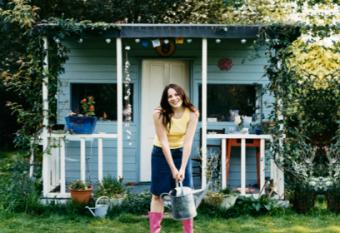
Tiny houses, often totaling 400 square feet or less, are definitely cute and on trend. However, with all the hype, it's natural to wonder whether they are really helpful to the environment. The short answer is yes. Tiny houses reduce the environmental impact of owners' homes by a significant margin.
Better to Build
The way people build things matters and can have long-term effects. Tiny houses are more environmentally friendly to build for several reasons.
Fewer Materials
Small houses use fewer building materials. An ordinary house requires about seven truckloads of lumber whereas a tiny house requires half of one truckload. This means fewer trees cut down for lumber, less fuel used in transporting materials, and other associated benefits.
More Potential for Environmentally Friendly Supplies
Because less material is needed, it's easier to build using recycled materials which are not always available in enough quantity for larger homes. By the same principle, it's more feasible to use more expensive, environmentally friendly materials instead of cheaper, conventional ones.
Lower "Life Cycle" Cost

The lifespan and replacement cost of materials is also important to consider, as well as the impact the replacement of these materials has on the planet. For instance, a tiny house may have a single bathroom instead of four bathrooms, meaning fewer fixtures to repair and replace over the years. The College of Saint Benedict and Saint John's University estimated that halving the size of a house reduces this "life cycle" cost by 36%.
Reduced Energy Use
Perhaps a tiny house's largest impact is due to its reduced energy use. According to a recent study from Oregon's Department of Land Quality, 86% of the total environmental impact of any house is due to its energy use. This includes space heating, water heating, and lighting.
An article from Colby College reports that the average sized (2,598 sq ft) house consumes about 12,773 kilowatt hours of energy per year. A tiny (186 sq ft) house, on the other hand, consumes only 914 kilowatt hours annually. Carbon dioxide emissions follow a similar pattern. Tiny houses averaging a yearly 2,000 pounds, while an average-sized house tops off at a whopping 28,000 pounds.
Fewer Appliances and Electrical Fixtures
The main reason for this energy use reduction is the obvious one: less space to heat and cool. There are some hidden reasons, too, though. One is having fewer appliances. The Colby College article reports that the average tiny house has six lightbulbs, compared to forty-five in a larger dwelling.
Less Time Spent Indoors
Another factor is that people in tiny houses necessarily spend more time outside. While many people find the layouts and features make these homes comfortable, their small size encourages an outdoor lifestyle. Living tiny necessitates use of the outdoors as a "second living space," much in the same way a person living in a tiny New York City apartment will spend much of his or her time in cafes, parks, and workspaces. Because of this, tiny houses consume less energy heating, cooling, or lighting the indoors.
Fewer Possessions, Less Waste
Living in a tiny house means having fewer possessions. This can be a big leap for many people, but those who have done it often report it as one of the best decisions they've ever made. When living tiny, people begin to value space more than trinkets and toys, and they only hold onto their most useful and valuable possessions. While this may mean giving away a lot at first, it comes with a bonus afterwords: buying less stuff.
As your consumption drops, so does your environmental impact. Anyone who's watched The Story of Stuff knows that the things we buy have a serious impact on the environment. This includes not only packaging, but extraction, fabrication, and transportation as well.
Increased Connection to the Environment

There aren't many people who think protecting the environment is a bad idea. However, consistent interaction with the outdoors makes it even more of a priority. Research in Carleton College's Undergraduate Journal of Humanistic Studies finds that tiny house owners interact more with nature and have more awareness of their interdependence with nature. While those in cities and suburbs are spending more and more time indoors, those who opt for tiny houses are able to forge a direct connection with nature.
Tiny housers also often depend on nature directly for things those in suburbia get in other ways, including heat (from wood), electricity (from the sun), and sometimes water from a nearby spring. Even those who are less dependent on nature for resources still live in direct contact with the environment everyday. This may translate to prioritizing the environment in most aspects of daily living.
Get Inspired by the Tiny House
The strength of the tiny house movement is its simplicity. Although this lifestyle isn't practical for everyone, you can easily apply a few lessons from the tiny house movement to your own regular-sized home. Consider reducing energy usage, buying less stuff, choosing green building materials, and spending more time outdoors. Tiny houses may be just one answer to living in a more environmentally friendly way, but they can also serve as inspiration.







